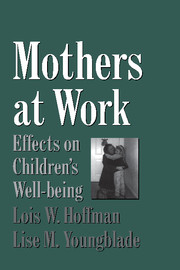Book contents
- Frontmatter
- Contents
- Preface
- 1 Introduction and Review of the Literature
- 2 Methodology
- 3 Children's Daily Family Lives: The After-School Day Interview
- 4 The Husband–Wife Relationship
- 5 The Mother's Well-being
- 6 Childrearing
- 7 Maternal Employment and Child Outcomes: The Direct Relationships
- 8 The Father's Role, Gender Attitudes, and Academic Outcomes
- 9 The Mother's Well-being and Child Outcomes
- 10 Childrearing Patterns and Child Outcomes
- 11 Nonmaternal Care and Supervision: Prevalence and Effects of Child-care Arrangements on Child Well-being
- 12 Summary and Overview
- Appendix: Measures Developed for This Study
- References
- Author Index
- Subject Index
Appendix: Measures Developed for This Study
Published online by Cambridge University Press: 06 July 2010
- Frontmatter
- Contents
- Preface
- 1 Introduction and Review of the Literature
- 2 Methodology
- 3 Children's Daily Family Lives: The After-School Day Interview
- 4 The Husband–Wife Relationship
- 5 The Mother's Well-being
- 6 Childrearing
- 7 Maternal Employment and Child Outcomes: The Direct Relationships
- 8 The Father's Role, Gender Attitudes, and Academic Outcomes
- 9 The Mother's Well-being and Child Outcomes
- 10 Childrearing Patterns and Child Outcomes
- 11 Nonmaternal Care and Supervision: Prevalence and Effects of Child-care Arrangements on Child Well-being
- 12 Summary and Overview
- Appendix: Measures Developed for This Study
- References
- Author Index
- Subject Index
Summary
Measures of the Father's Role
Division of Labor Between Parents: The “Who Does It More” Measure
The same measure was administered to mothers and fathers, but mothers were administered it in a personal interview and the fathers' form was selfadministered. The format used with mothers is presented here.
We are interested in how parents divide household tasks and activities. I'm going to read some family activities and I'd like you to tell me if you do it, your husband does it, or, if both, who does it more. Here is a card with the possible answers. (Interviewer hands card to mother.)
Mother–not father
Mother mostly but father sometimes
Both pretty equally
Father mostly but mother sometimes
Father–not mother
Neither does it
Here are the questions:
Gets breakfast–Who gets breakfast in your family–you and not your husband, you mostly, pretty equally, your husband more, only your husband?
Mows the lawn and shovels the snow?
Cleans and dusts?
Cooks the evening meal?
Washes and cleans the car?
Fixes things when they go wrong like stopped-up sinks and blown-out fuses?
Cleans the basement and the garage?
Does the dishes?
Sets the table?
Makes the beds?
Gets the children to eat the foods they should?
Gets the children to help around the house?
Gets the children to go to bed?
Takes care of the children?
Makes sure the children get to school on time?
[…]
- Type
- Chapter
- Information
- Mothers at WorkEffects on Children's Well-Being, pp. 297 - 312Publisher: Cambridge University PressPrint publication year: 1999



